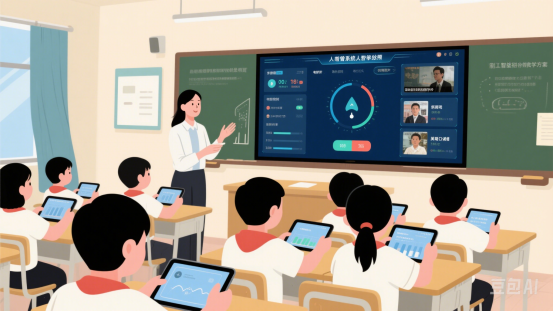
As artificial intelligence changes industries across China, its powerful role in education is creating fair chances for students everywhere. From busy cities to faraway mountain villages, AI tools are transforming classrooms and reducing the education gap between cities and rural areas.
1.1. What is the main advantage of the smart classroom system?
A It makes teaching materials more interesting.
B It helps find students’ difficulties quickly.
C It can correct students’ mistakes in time.
D It offers more English learning resources.
解析:选B。B 细节理解题。根据第二段的“By studying the data, the system helps Zeng find where students struggle and create focused lesson plans.”“It works much faster than old ways.”可知,智能教室系统通过分析数据,能帮助老师快速发现学生的学习难点,这比传统方法要快得多。故选B。
2.2. What do students at Tsinghua University Primary School do with smart sports tools?
A They use them to take PE classes.
B They use them to do after-school sports.
C They use them during breaks for fun exercise.
D They use them to compete with each other.
解析:选C。C 细节理解题。根据第四段的“At Tsinghua University Primary School, students use smart sports tools during breaks.”可以看出,在清华大学附属小学,学生们是在课间休息时使用智能运动工具,将运动与乐趣相结合。故选C。
3.3. What does Qian Minghui think of the AI helper DeepSeek?
A It is a useful research tool.
B It can replace human researchers.
C It is only suitable for big universities.
D It works better in data collection.
解析:选A。A 推理判断题。根据第五段的“Schools like Renmin University use tools like the AI helper DeepSeek to speed up research. ‘It works like a round-the-clock research helper,’ says staff member Qian Minghui.”可知,钱明辉说人工智能助手DeepSeek就像一个全天候的研究助手,能帮助加快研究速度,这表明他认为DeepSeek是一个很有用的研究工具。故选A。
4.4. Why do schools need clear rules according to Tang Liang?
A To make better use of AI.
B To reduce the use of AI.
C To stop students from using AI.
D To protect data safety.
解析:选D。D细节理解题。根据最后一段的“Tang Liang, an education researcher, says schools need clear rules, tech monitoring, and ethics lessons to protect privacy and prevent cheating.”可知,唐亮认为学校需要明确的规则来保护隐私和防止作弊,也就是为了保障数据安全。故选D。